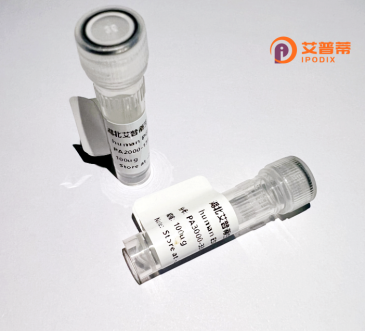
| 纯度 | >90%SDS-PAGE. |
| 种属 | Human |
| 靶点 | RFXAP |
| Uniprot No | O00287 |
| 内毒素 | < 0.01EU/μg |
| 表达宿主 | E.coli |
| 表达区间 | 1-272 aa |
| 活性数据 | MEAQGVAEGA GPGAASGVPH PAALAPAAAP TLAPASVAAA ASQFTLLVMQ PCAGQDEAAA PGGSVGAGKP VRYLCEGAGD GEEEAGEDEA DLLDTSDPPG GGESAASLED LEDEETHSGG EGSSGGARRR GSGGGSMSKT CTYEGCSETT SQVAKQRKPW MCKKHRNKMY KDKYKKKKSD QALNCGGTAS TGSAGNVKLE ESADNILSIV KQRTGSFGDR PARPTLLEQV LNQKRLSLLR SPEVVQFLQK QQQLLNQQVL EQRQQQFPGT SM |
| 分子量 | 28.2 kDa |
| 蛋白标签 | His tag N-Terminus |
| 缓冲液 | PBS, pH7.4, containing 0.01% SKL, 1mM DTT, 5% Trehalose and Proclin300. |
| 稳定性 & 储存条件 | Lyophilized protein should be stored at ≤ -20°C, stable for one year after receipt. Reconstituted protein solution can be stored at 2-8°C for 2-7 days. Aliquots of reconstituted samples are stable at ≤ -20°C for 3 months. |
| 复溶 | Always centrifuge tubes before opening.Do not mix by vortex or pipetting. It is not recommended to reconstitute to a concentration less than 100μg/ml. Dissolve the lyophilized protein in distilled water. Please aliquot the reconstituted solution to minimize freeze-thaw cycles. |
以下是关于重组人RFXAP蛋白的3篇经典参考文献及其摘要概括:
1. **文献名称**:*MHC class II regulatory factor RFXAP binds to the RFX DNA-binding domain through a conserved α-helix motif*
**作者**:Reith W, et al.
**摘要**:该研究阐明了RFXAP作为RFX复合物的关键亚基,通过保守的α-螺旋结构与RFX5的DNA结合域相互作用,共同调控MHC II类基因的转录激活,揭示了其异常表达与严重免疫缺陷的关联。
2. **文献名称**:*Complementation cloning of the MHC class II transactivator (CIITA) gene in patients with inherited MHC class II deficiency*
**作者**:Steimle V, et al.
**摘要**:研究发现,RFXAP基因突变可导致MHC II类分子表达缺失,引发联合免疫缺陷(如裸淋巴细胞综合征),实验通过互补克隆验证了RFXAP与CIITA协同调控MHC II类启动子的功能。
3. **文献名称**:*The molecular basis of MHC class II deficiency (BLS patients) in the context of regulatory factor X complex structure*
**作者**:Villard J, et al.
**摘要**:本文系统分析了RFX复合物(RFXAP/RFX5/RFXANK)的组装机制,证明RFXAP缺乏会破坏复合体稳定性,导致MHC II类分子无法正常表达,为临床基因诊断提供了理论依据。
这些文献从分子机制、疾病关联及复合物结构层面解析了RFXAP的功能,适合作为深入研究的基础参考资料。
RFX-associated protein (RFXAP) is a critical regulatory factor involved in the transcriptional activation of major histocompatibility complex class II (MHC II) genes, which play a central role in adaptive immunity. As a member of the RFX family, RFXAP interacts with RFX5 and RFXANK to form the RFX complex, essential for binding the X-box promoter region of MHC II genes. This complex facilitates the recruitment of additional coactivators, such as CIITA (class II transactivator), to initiate MHC II gene expression. MHC II molecules are required for antigen presentation to CD4+ T cells, enabling immune responses against pathogens.
Mutations in RFXAP are linked to MHC II deficiency, a severe autosomal recessive immunodeficiency disorder (also called bare lymphocyte syndrome). Affected individuals exhibit impaired cellular and humoral immunity, leading to recurrent infections, often in early childhood. Studies of RFXAP have provided insights into the molecular mechanisms governing MHC II regulation and immune system development.
Recombinant human RFXAP is produced using heterologous expression systems (e.g., E. coli, mammalian cells) for in vitro research, including functional studies, protein-protein interaction assays, and drug screening. Its structural characterization (e.g., leucine-rich repeats) and interactions with other RFX components remain key areas of investigation for understanding immune dysregulation and developing therapeutic strategies.
×